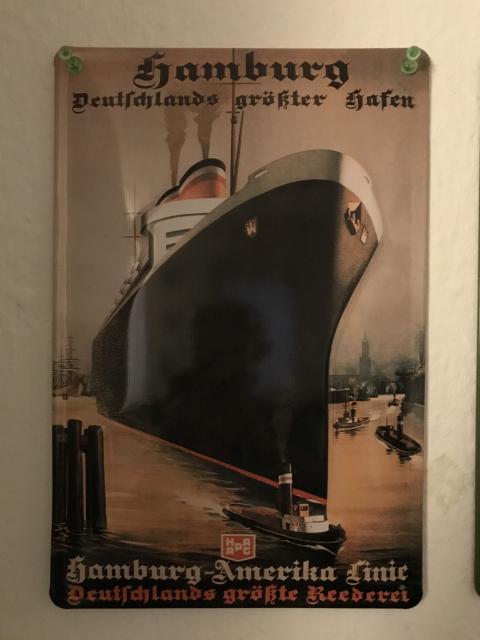Before I relive the recent weekend I spent in Hamburg, I have to discuss something that non-Europeans, especially Americans, overlook about Germany: it may be a lot smaller than the United States, but it's more culturally diverse. I recently found a great listicle on the Chive, one of those light entertainment sites I use for after-work unwinding, about what Hollywood gets wrong about people's countries. In this list I found a picture of a woman decked out in Dirndl standing next to a Warsteiner beer tap, captioned "Bavaria is not our whole country." That's so true.
Think of it like this. Bavaria is to Germany what Texas is to the States. It's the source of a good deal of stereotypes, especially about clothing, food, and music, that outsiders apply to the whole country but are really only applicable to that one state and not much else. Dirndl and Lederhosen are traditional clothing of Bavaria, but they would look extremely out of place in Hamburg, just as cowboy hats would look out of place in Boston.
Now then, let's spend a weekend in not-Bavaria. Hamburg is a port city on the river Elbe, about 100 miles from the North Sea, with a storied maritime history. There's a reason I compared it to Boston in the last paragraph...but there's a little bit of Miami in it too, which is apparent any time you catch a glimpse of a monstrous cruise ship moored there. For centuries it was the most important city of the famous Hanseatic League, the trade confederation that lasted for nearly a millenium. For most of its history, Hamburg has been independent of all its neighbors, never subject to any of the kings, dukes, princes, and such that were always exchanging and fighting over territories during the heyday of the Hansa. Even today, the city itself is its own state within Germany with the mayor and city council doubling as governor and state legislature.
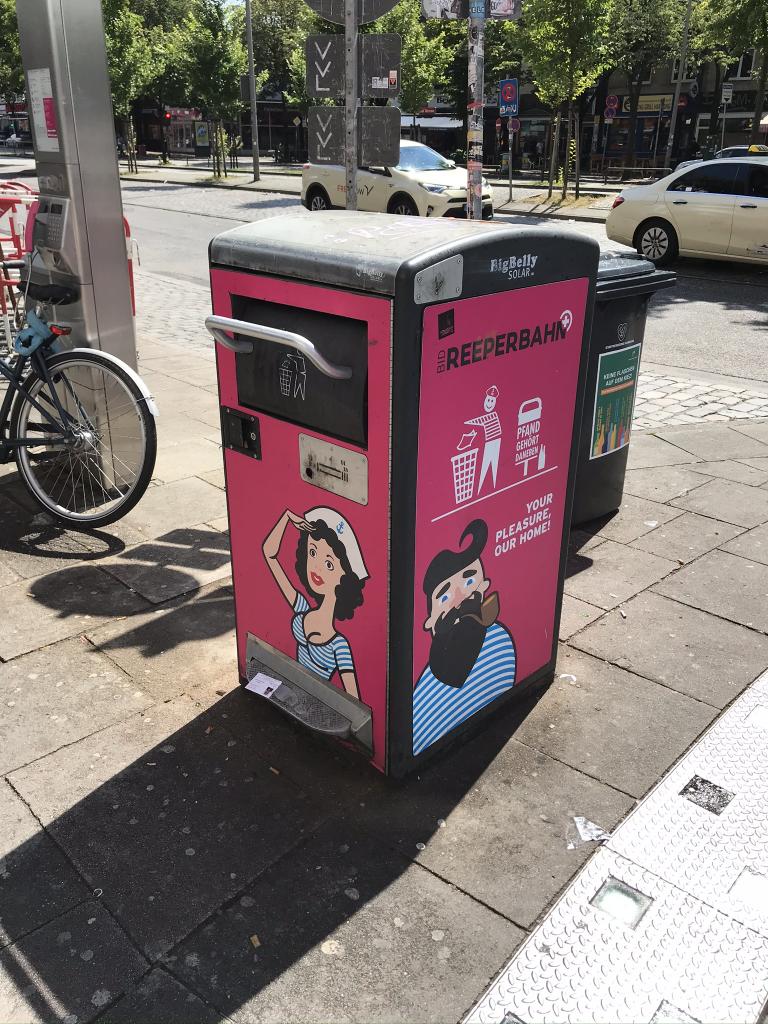
One of many ways Hamburg's heritage is on display.
Friday, July 24, 2020
I travelled to the city on trains, as usual, on a Friday evening. First I spent two hours and change from Stuttgart to Frankfurt's central station on an IC. After that it was only supposed to be, I think, an 18-minute layover, but my next train was delayed by no less than 40 minutes! Thankfully, Frankfurt's train station, like most other big ones in this part of the world, has plenty of good restaurants so I got a delicious sandwich for dinner while waiting. The second and last train was a high-speed ICE which got me from Frankfurt to Hamburg's central station in just under four hours, pulling in at around midnight.
The place where I was staying was an a&o hostel. I'd had a good experience at the a&o Hamburg City the last time I was in town, which was just to stay the night on the way to Norway last December, which is why I wanted to stay with them again, this time at the a&o Hauptbahnhof. Even though it's relatively close to the train station, hence the "Hauptbahnhof" name, it's not exactly next door. Getting there from the train station did require a little bit of a walk and some consultation with my phone's map app.
It was late and I was tired and so had no desire to seek out any nightlife. However they did serve draft beer in the hostel lobby (one reason why I like a&o) so I had a glass of Astra.
Saturday, July 25, 2020
Another reason I like a&o: they can serve a great breakfast there. But, thanks to the pandemic, it's no longer a buffet where you can just take whatever you want whenever you want. Now, you have to fill out a form which contains a list of all available food items, where next to any item you want you write down how much of it you want. Then at the counter you hand it to the kitchen staff and they'll serve it up for you. On both days I had müsli, turkey cold cuts, and a banana with coffee.
So first I rode some public transit trains around to familiarize myself with the system. Hamburg is a major city so naturally it has both U-Bahn and S-Bahn systems. For those of you who are unfamiliar with what that means: the U-Bahn is the subway system. In most German cities U-Bahn is a light rail, but in the biggest cities like Hamburg, it's a subway just like New York's and London's. S-Bahn, meanwhile, is a commuter rail whose function is to connect the city with the suburbs, while only hitting the most important stops in the city itself. Surprisingly I found myself using the S-Bahn far more often than the U-Bahn, probably just because most the places I wanted to see were near S-Bahn stops, and it's a pretty big city and S-Bahn is faster.
Eventually I stopped at a famous street in the St. Pauli neighborhood called Reeperbahn and walked down most of it. Most everything was closed, after all it was still morning, but I just wanted to have a look at this district before returning later.
I had to hit up one building to get it out of the way. I took the S-Bahn back to the city center...
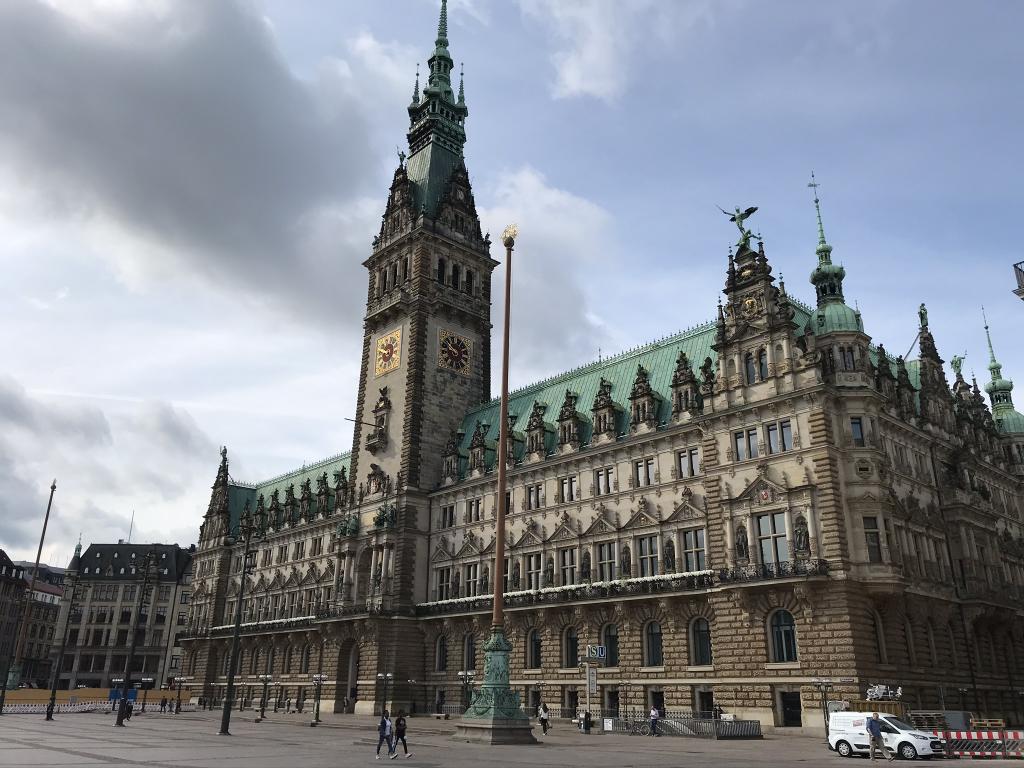
This historic structure is the Rathaus, or city hall. And since Hamburg is its own state, this essentially serves as a Landtaghaus (state parliament building) as well.
I wanted to take a tour of the Rathaus, but tours were all suspended indefinitely. Thanks, Covid! All I could do was walk around the lobby.
Next up: the Hafenmuseum (Port Museum) which is a museum dedicated to the shipping which has been the core of Hamburg's economy for centuries. The museum is pretty small but it can take awhile to get through because there is a lot of history and it's a real learning experience.
As I've already mentioned, Hamburg was the most important member of the Hanseatic League. Even though the League is long gone, the city is still the gateway to Europe for untold tons of freight. Goods from all over the world arrive here to be moved by truck and train to destinations throughout Europe. Just as many European goods ride trucks and trains here to be shipped off to other continents.
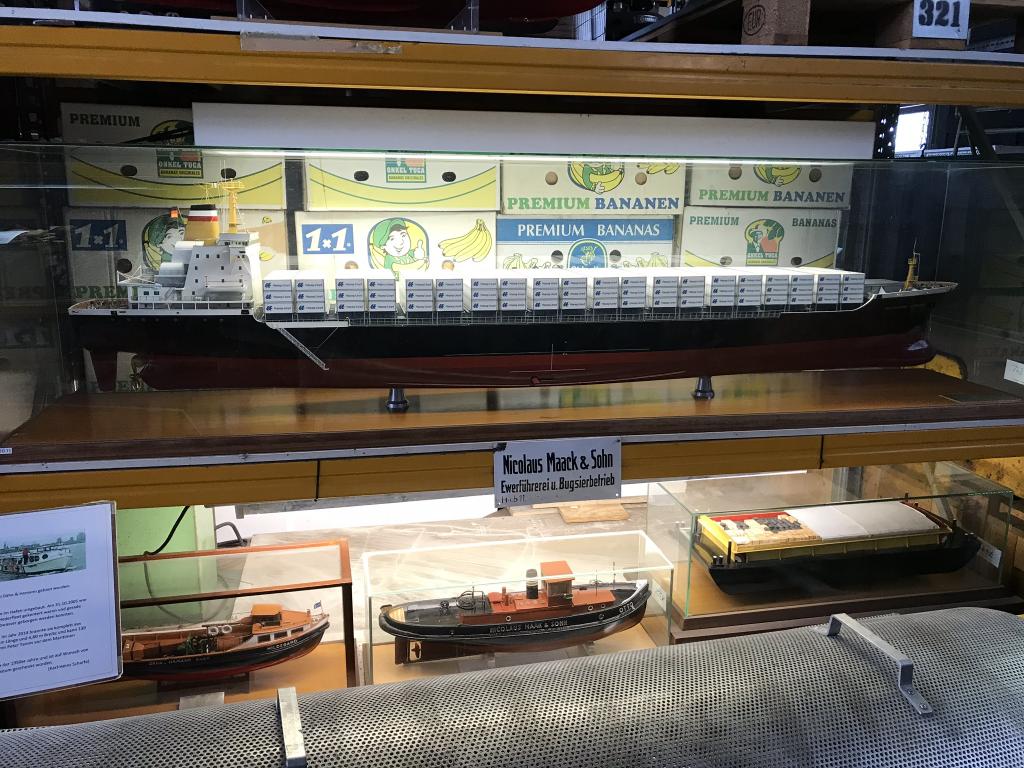
A model of a typical container ship. This one specifically transported a commodity I absolutely can't live without: bananas. The invention of containerized cargo in the last century, in which each huge box is dedicated to a specific type of cargo, really revolutionized the shipping industry, though at the cost of many longshoremen's jobs. Over on YouTube, PolyMatter made a great explainer video about this topic.
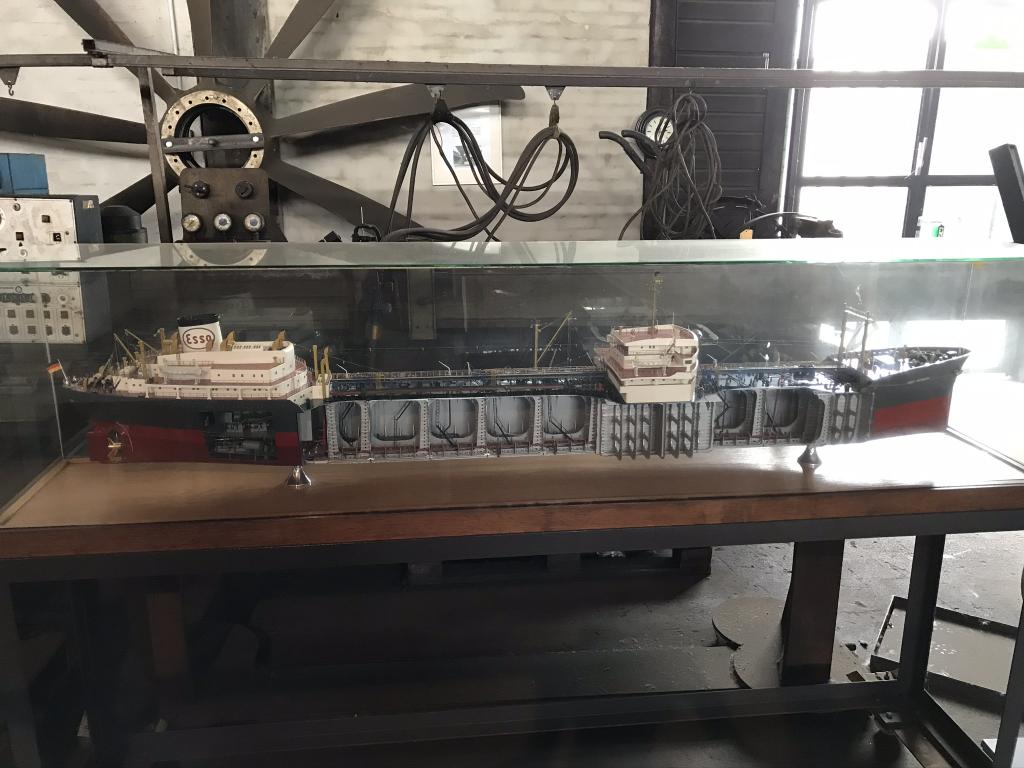
Cutaway model of a typical oil tanker. Notice how compartmentalized it is. The ship's hold has to be divided into all those tanks, because if it wasn't and all the oil was in one enormous tank, all the sloshing around would make the ship capsize.
It's not just cargo; Hamburg is also a busy port for passenger ships. Today German cruise lines like Aida launch their cruise ships from here. Remember that TUI "Mein Schiff" I spotted in Cozumel a few years back? It doubtless started its journey in Hamburg. A century ago Hamburg was the hub of the Hamburg-Amerika line which sent superliners back and forth between Hamburg and New York City.
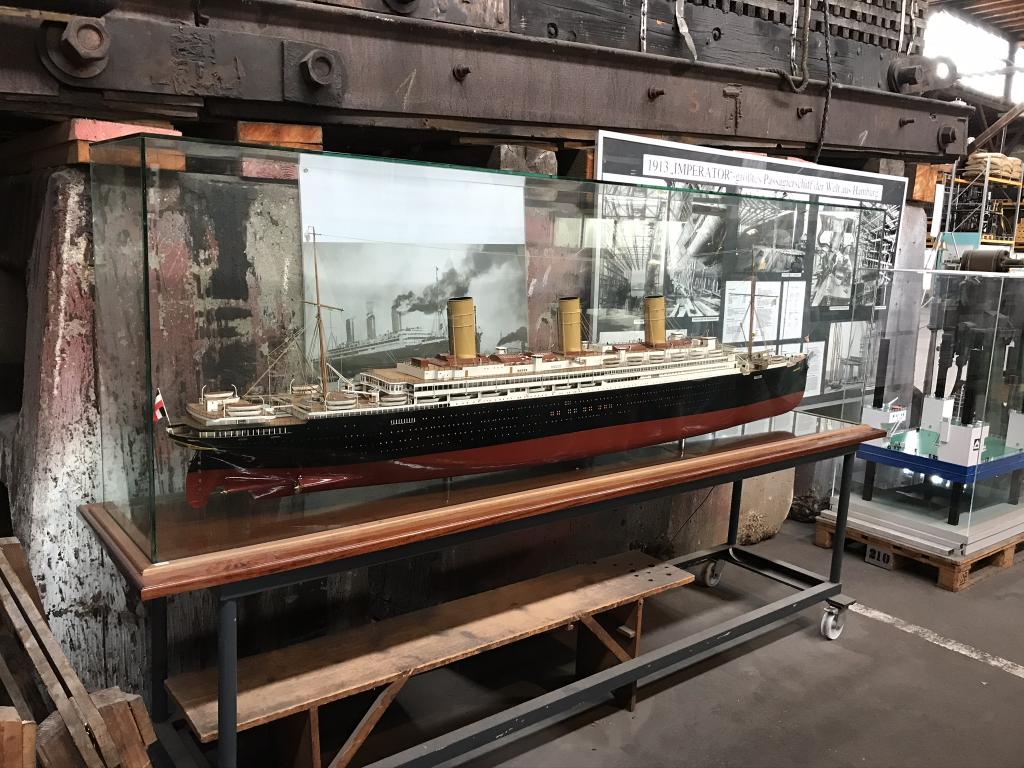
Recognize this ship? You probably don't. The Imperator was launched from Hamburg in 1913 and was the biggest passenger ship in the world, even bigger than the Titanic which sunk the year before. But this one never struck an iceberg which is why you’ve never heard of it. Imperator did seven transatlantic crossings before WWI broke out, was sold to the UK‘s Cunard Line in 1920 and was renamed Berengaria, and kept on sailing till 1938 when she was badly damaged in a fire while docked in New York Harbor.
Outside the museum people were paying to bungee-jump from the top of one of the cranes. Nein danke! I took an S-Bahn back to St. Pauli and walked to the waterfront. The whole dock is lined with souvenir shops and little restaurants. While walking up and down the dock area I found that one could do harbor cruises. There were one-hour and two-hour cruises available. I went with the one-hour option.
I did this one-hour cruise on the most incongruous-looking ship I saw docked in this city, a ship called Louisiana Star, which had a paddlewheel and generally looked like the sort of ship you'd expect to find cruising the Mississippi river circa 1890. All the space within suggested to me that this ship's used for more than just one-hour cruises; there were two indoor decks which both had bars, tables and chairs, and dancefloors. I and most of the one-hour tourists went up top to watch the scenery go by.
So the Louisiana Star slowly sailed all around the harbor. All of us on board got to see not only many of the buildings on the banks of the Elbe, but also all kinds of different ships that were docked there.
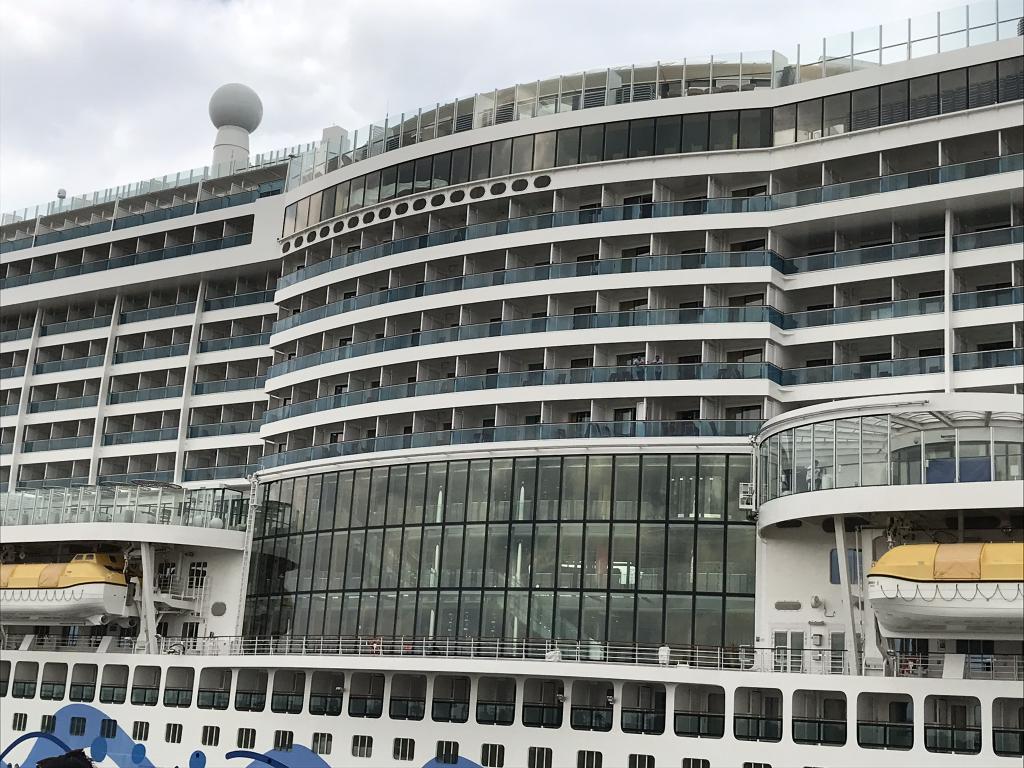
This is a cruise ship operated by the German cruise line Aida. If cruise ships are sailing again after the pandemic, I'd love to sail on something like this because it sure looks a lot more impressive than the Carnival ships I've been on.
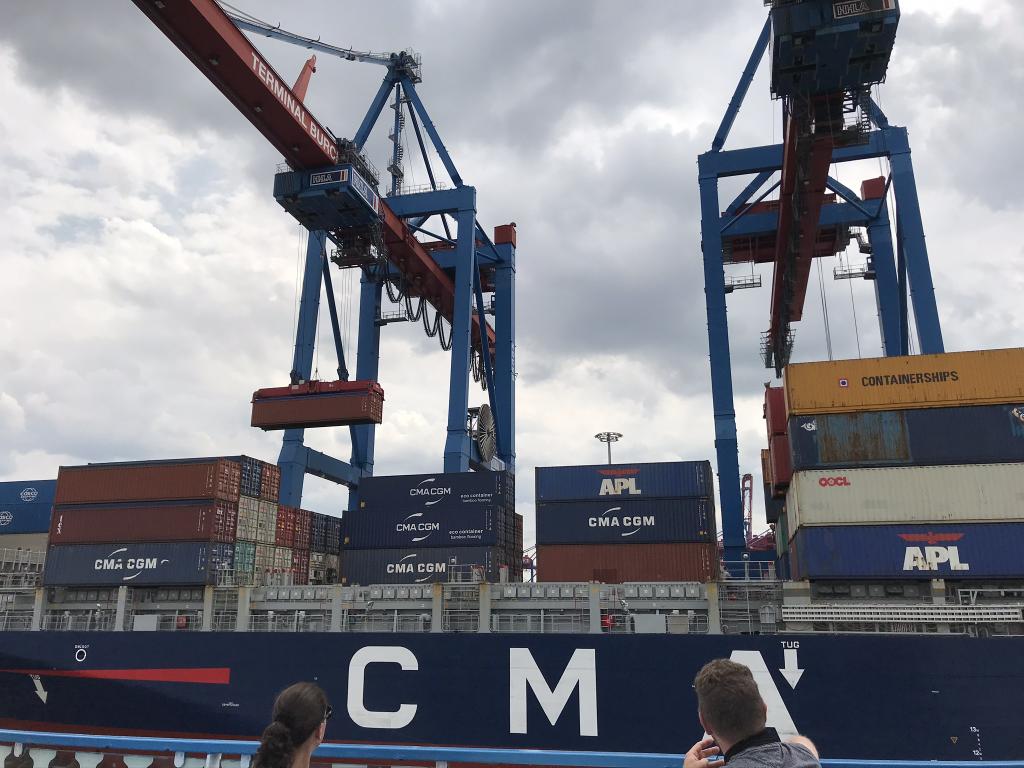
If you've ever seen containers with these logos on them riding on a freight train, there's a chance it may have either been shipped from here or was on its way here.
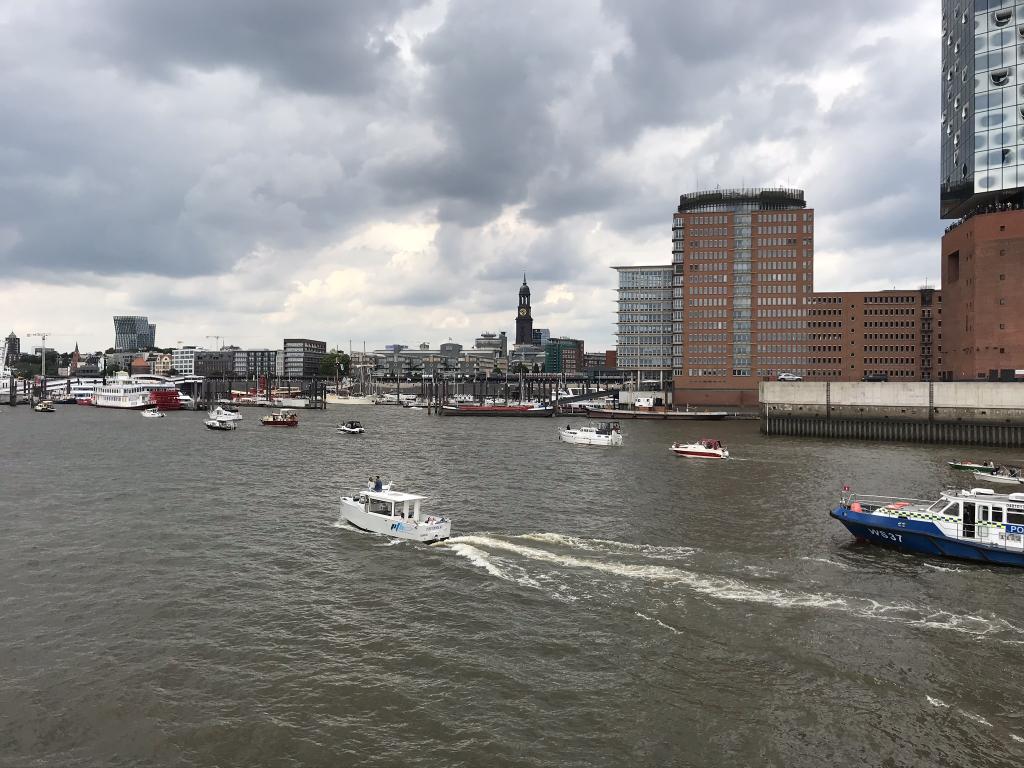
A great view of the city and waterfront as our short cruise came to an end.
I had my first beer of the day on that ship during the cruise, a 30cl Holsten Pils which was pretty good.
Now time to get immersed in history once again.
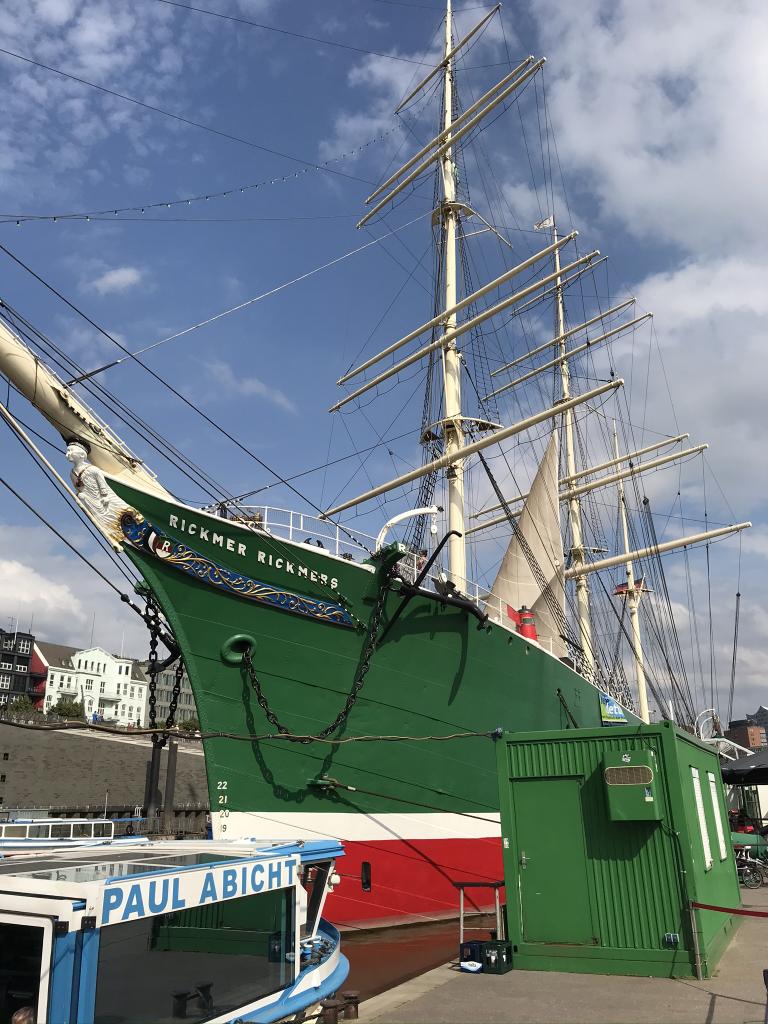
This tall windjammer is the museum ship Rickmer Rickmers. She's not as old as you might think, having been built in 1896. That may seem a little too recent for a sailing ship, because most ships were steam powered by then; windjammers like this were the last gasp of commercial sailing. It was apparently still profitable to send freight around the Cape of Good Hope on sails rather than through the then-new Suez Canal on a steamer. This ship was originally owned by the Bremerhaven-based Rickmers line, sold to the Hamburg-based Krabbenhöft line and renamed Max in 1912, and then captured by the Portuguese in 1914, during WWI, who renamed her Sagres. Under that name, the Sagres was a training vessel for the Portuguese navy all the way up until 1983.
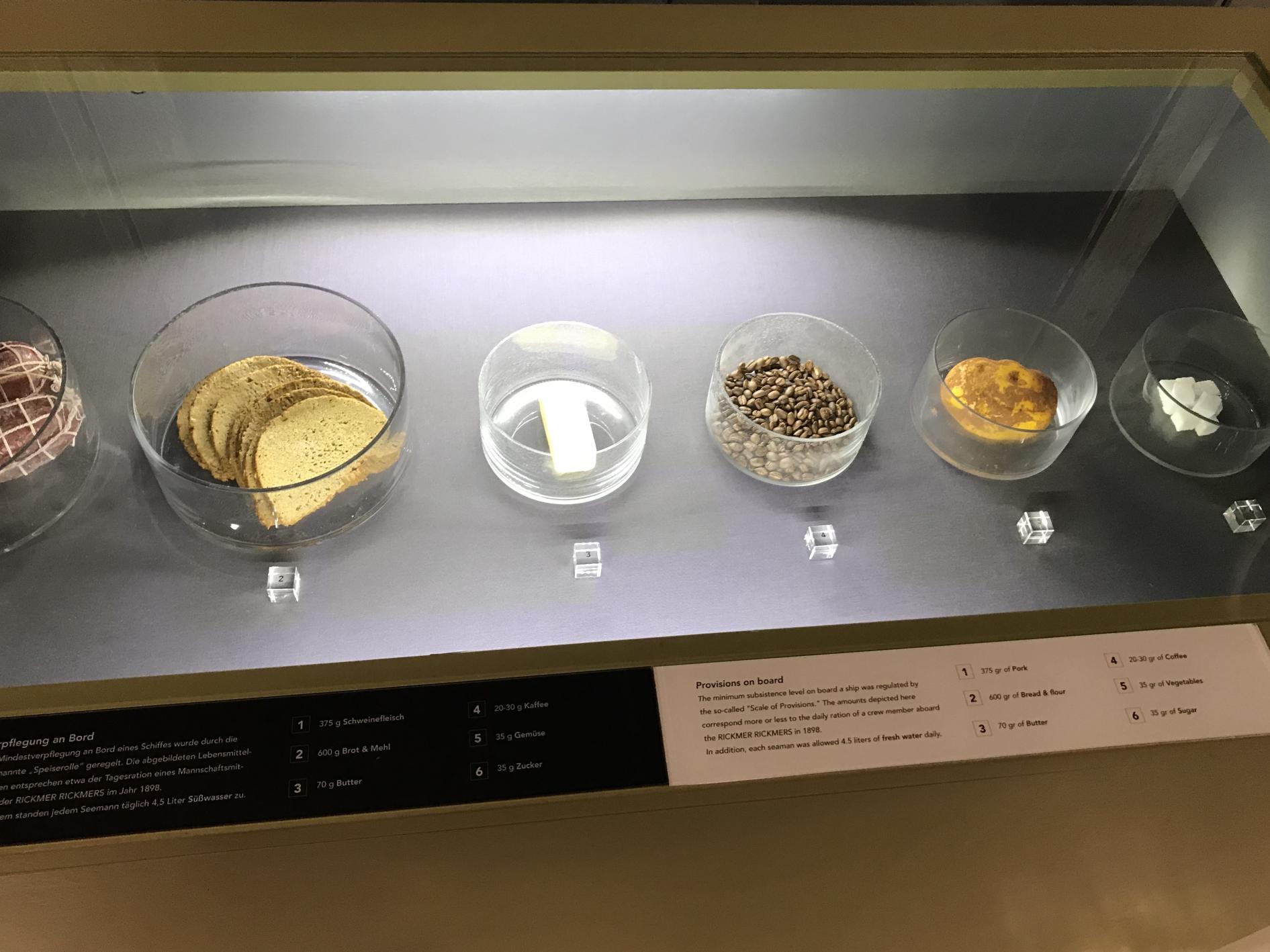
This is what common sailors ate back then, at the turn of the last century. Pork, bread, butter, coffee, some unidentified vegetable, and sugar. Ehh...not too bad I suppose, but it would probably get boring after a while. Even canned vegetables, one informational sign said, were considered a luxury. Of course, the officers ate better, and the captain ate a lot better. They actually kept some live chickens aboard, to be slaughtered and used for food, but that food only ended up on the captain's table.
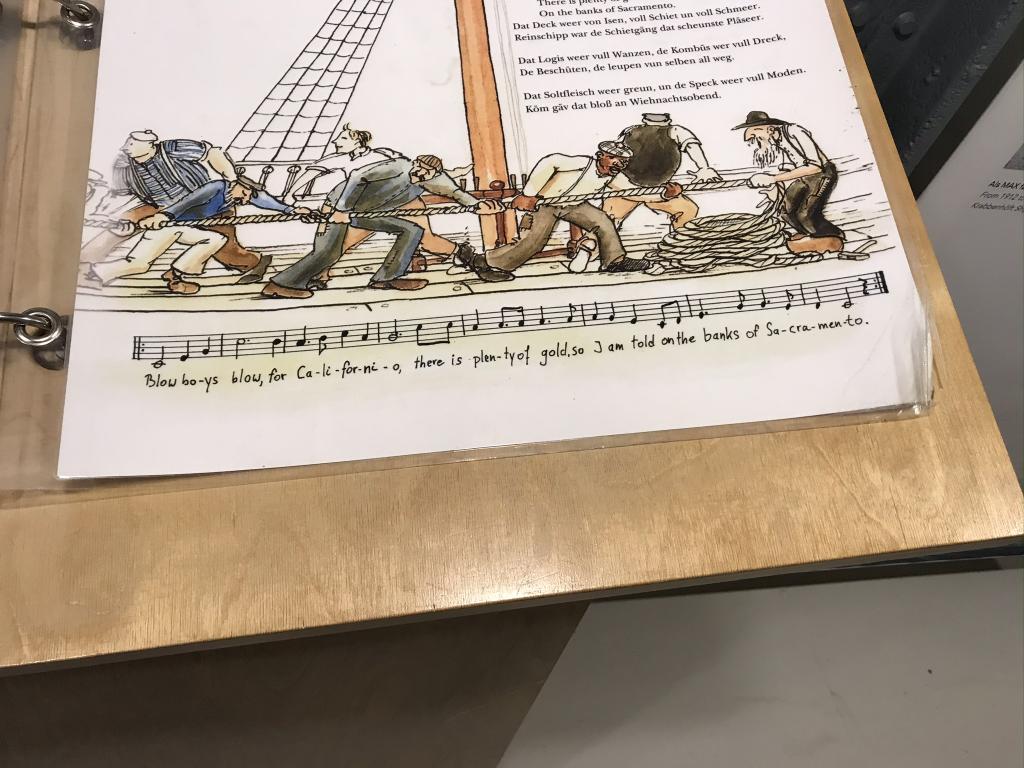
This song is a famous sea shanty, "Hamborger Veermaster," whose lyrics are mostly in Low German (the traditional language of northern Germany) but with an English chorus. Sea shanties were songs sung by sailors as they labored on the decks of ships at sea all day. The purpose of these songs was to keep the crew synchronized as they worked together and pass the day more smoothly. "Hamborger Veermaster" (Hamburger Four-master) was a particularly famous one. The next day I heard a recording of it playing as background music in Blockbräu, a restaurant I ate at.
After the tour of the Rickmer Rickmers, I stopped for dinner at one of the little restaurants on the dock. I had a sandwich called a Brötchen. Specifically this was a fish sandwich. This place was selling quite a variety of Brötchen with different kinds of fish, and the one I got was called "Bismarck." I liked it, even if I couldn't figure out what kind of fish "Bismarck" was. After that I headed back to the hostel for a quick shower and change of clothes before hitting up the bars.
So it was now Saturday night, I was done with all the museums and stuff, now it was time to go bar hopping on the Reeperbahn! First, as we all know by now, I have to stop at an Irish pub in every city I visit and have at the very least an Irish Coffee. The first place I stopped at was called Murphy's Irish Pub, and I started off with a pint of Murphy's Irish Red. Then I asked for an Irish Coffee, and it turns out they don't serve coffee there!
Second stop was not an Irish pub but an English one, simply called London Pub. I was hoping a place with such a name and theme would have one of those English brown ales on tap, but they didn't. It was mostly just German and some Irish beer, but they also had something that was weirdly authentic for an English pub: Fosters. That may be Australian, but it's on tap at nearly every pub I've ever been to in England, so I had to have a pint here.
Next up was a nice looking place called Albers. They had a row of taps along the bar, but they were all shut off for some undisclosed reason, so I just had a bottle of Astra.
Then I wandered into a slightly swanky-looking establishment called Monopol. Here, unexpectedly, I found Irish Coffee on the menu! So of course, I ordered one, but I didn't like it too much as there was no sweetener or sugar in it.
My penultimate stop that night was a brewpub called Brewdog. This was a place that made their own beer and had several varieties on offer. One of these was a milk stout called Jet Black Heart. I knew I'd have to have this. Milk stout is a kind of beer that I really like but is pretty rare in Europe. Back in the States there's more craft brewers than I can count making milk stouts, the most widely proliferated one being the one made by Left Hand in Colorado. I don't think I'd had a milk stout since leaving the States so I had to order a 33cl of this Jet Black Heart. And...I liked it but didn't love it. It tasted rather strong and bitter. Not bad, but Left Hand is better.
I'd mostly had enough by then but stopped in one more place, Hamburger Alm. This one was memorable because of its theme: it was meant to look like a bar at a ski resort. There were skis and snowboards mounted on the walls and the sound system was playing Schlager music. Even the name suggests a ski resort bar, as Alpine ski resorts are full of bars and restaurants with names ending in "Alm." I think this was supposed to be funny because this low-lying port city isn't exactly close to any snowy mountains. I had a good but unremarkable Holsten Bernstein lager.
Eventually sometime not too long after midnight, when I left Hamburger Alm, I decided it would be a good time to end this night out. I was, you see, a little concerned about the disease going around. As I made my way up and down this street, it was plenty crowded, no one was maintaining any kind of social distance, and absolutely no one had a face mask on. I'd read too many news articles about coronavirus outbreaks at big birthday parties, weddings, megachurch services, and such, in which no one took any precautions, so I could only be around these crowds for so long before I thought "I better end it here." I'm still doing OK so I don't think I caught anything...
But if I, or anyone else in the places I visited while I was there, had caught the virus, someone would have tracked me down eventually. At every single eating and drinking establishment I visited during this trip, I had to leave my name, address, and phone number with them, for contact tracing purposes. I felt a little uncomfortable with this, having to leave such information with so many people, but I could understand why they were doing that.
Sunday, July 26, 2020
Sunday morning I groggily woke up, looked at the time, and realized I probably wasn't going to make it to the Fish Market. Every Sunday morning in Hamburg there is a famous bustling open-air fish market, Fischmarkt in German, which occurs at the Fish Auction Hall right on the harbor in the St. Pauli neighborhood. This market closes at 9:30 sharp, when, so I've heard, the vendors close up shop and clear out of the place astonishingly quickly. Well, I woke up just before 8:00. I knew there was no chance of actually getting to the market before it closed, since I still had to drag myself out of bed...go downstairs and eat breakfast...walk to the train station...ride an S-Bahn out to the closest stop to the market...take a bit of a walk to get to the waterfront... Needless to say, I didn't have a chance of getting there in time, and I didn't, but I went anyway, just to see the building if nothing else.
Later I had lunch at Blockbräu, a restaurant/brewery on the waterfront. I had a pretty good chicken salad and an OK house-brewed Pilsner.
Before leaving the docks I stopped at the Astra Biergarten where I did not have Astra, but instead a Maisel Weiße. I didn't notice until after I bought it and looked at the logo on the glass that it was not a local brew but came from Bayreuth in Bavaria. Still a pretty good wheat beer.
There was still one more sight to see, back in St. Pauli. The Beatles had spent part of their early career (1960-1962) in Hamburg playing in clubs in St. Pauli. Their time in Hamburg is memorialized at a spot on the Reeperbahn and I had apparently passed it without noticing the day before.
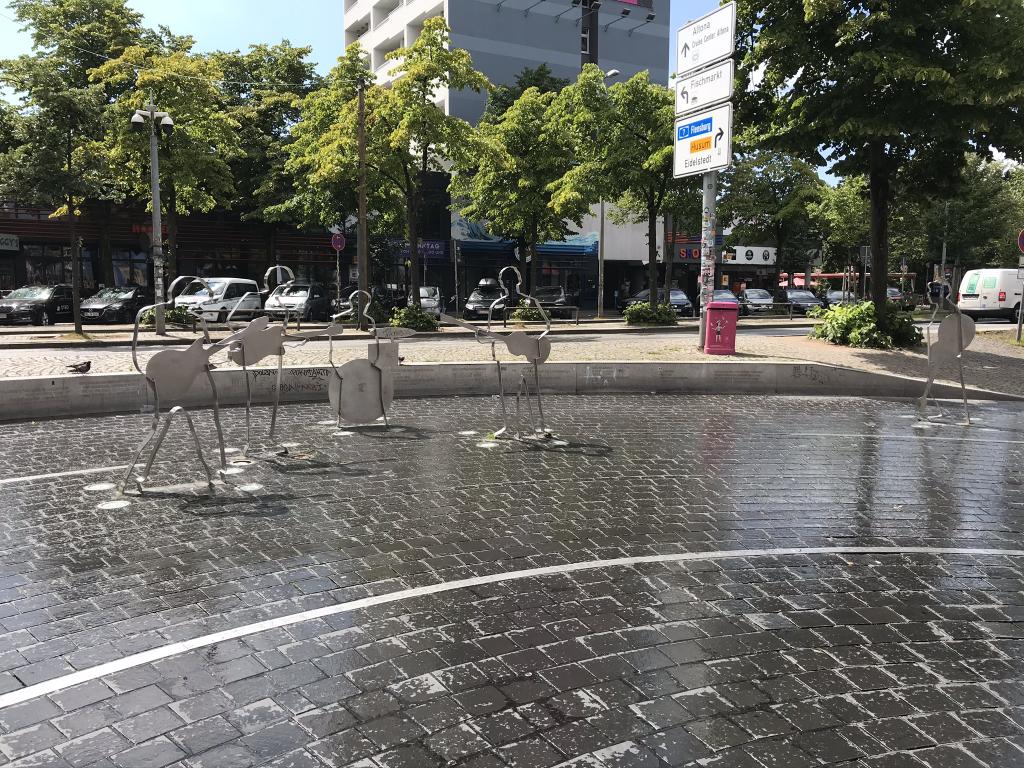
This spot at the intersection of Reeperbahn and Große Freiheit is named Beatles-Platz. I didn't notice this when I was there, but look at the ground: this area is a huge circle made of concentric rings of shiny black bricks. It's supposed to look like a vinyl record. Now look at the outlined statues. Who's the fifth member off to the right? That's Stuart Sutcliffe, who was the original bassist in the early years. He left the band during the Hamburg days, leaving Paul to take over on bass, only to die of a brain hemorrhage soon after, never to see his former bandmates be the cultural icons they would become. The drummer figure, meanwhile, is meant to represent both Pete Best and Ringo Starr; the latter replaced the former while they were in Hamburg.
I knew from my visit to the Beatles Story museum in Liverpool five years earlier that one of the Hamburg clubs where they regularly played gigs was called Star Club. I looked this up on Wikipedia and found that the club was at Große Freiheit 39, but had closed in 1969 and the building burned down in 1987. So what's at that address now?
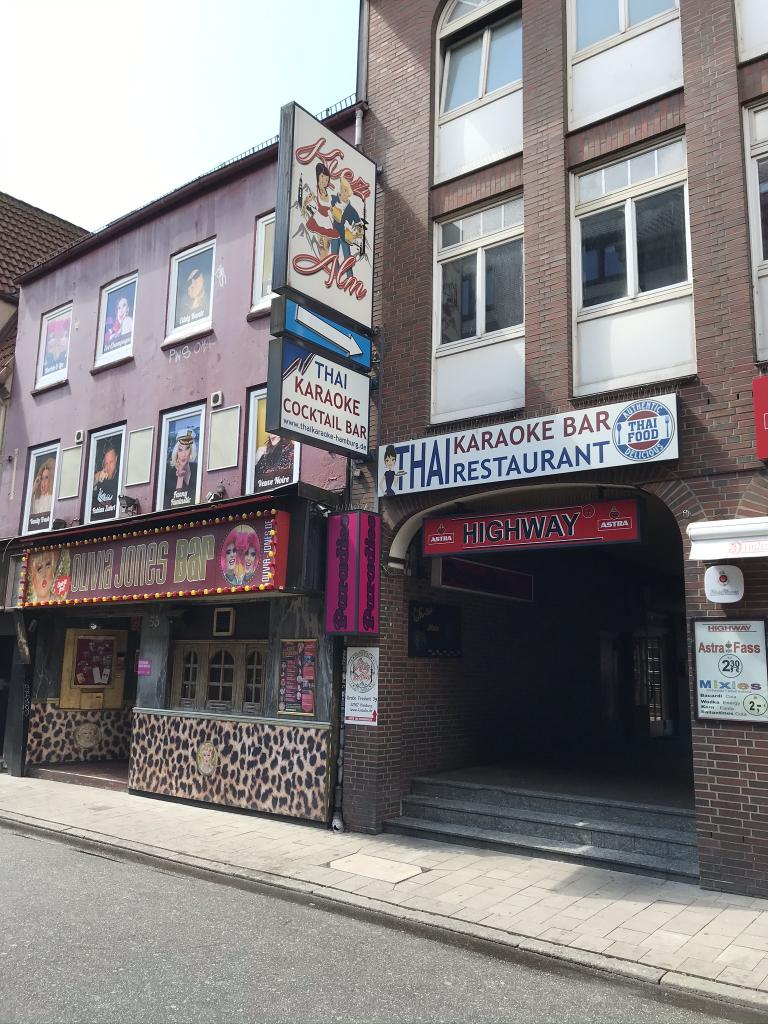
A bar called Kiez Alm, apparently, which seems to be another pseudo-Bavarian imitation ski lodge bar. It would've been nice to stop in and have a drink on a spot where the Beatles once played, but it was closed.
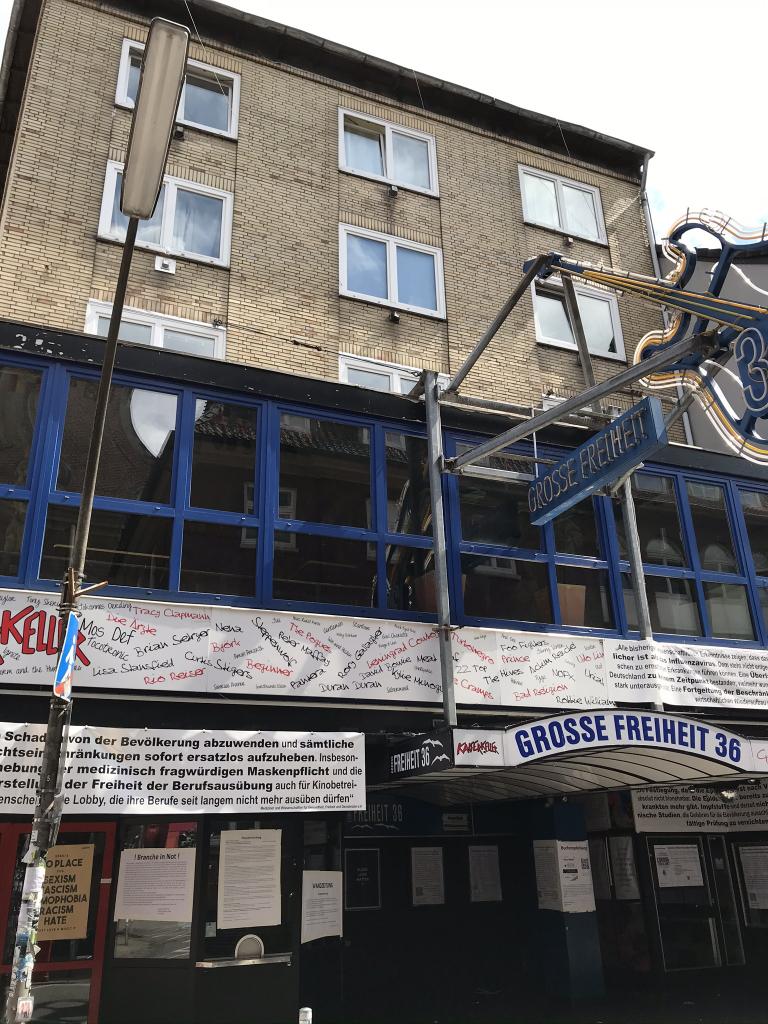
The Kaiserkeller also hosted Beatles gigs, and amazingly enough, this place is still going after all these decades.
My last stop before heading back to the train station was Hamburger Alm, which was one of the few places on the Reeperbahn open on a Sunday afternoon, and had a Duckstein Rotblond. That's a beer style I'd never even heard of before, some kind of cross between a blonde and an amber ale. Pretty good.
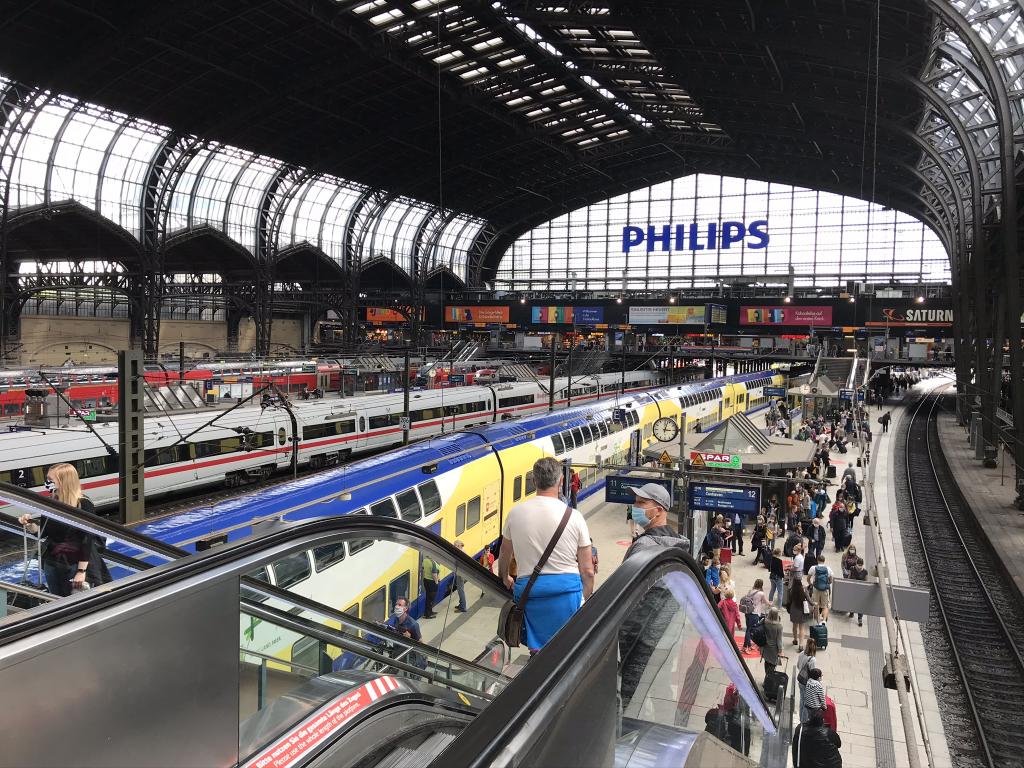
Inside Hamburg's bustling central train station. That white train with the red stripe is a high-speed ICE. A nearly-identical one would, just a few minutes after I took this, pull into the empty track on the right for me to ride home.
Because this was a direct trip without any transfers, it was on this return trip that the advantages of high-speed rail became clearer than ever. It took exactly six hours for ICE 771 to get from Hamburg Hauptbahnhof to Stuttgart. Now, these two cities are about as far apart as San Antonio and Oklahoma City. How long does a road trip between those cities take? I'd wager at least eight hours, if not nine, because six hours is how long it always took me to drive from San Antonio to Dallas. If you're not too familiar with the local geography there, SA-Dallas is a little more than half the distance as SA-Oklahoma City. I'm still not so sure that HSR would be a good fit for the States (though I'd be the first in line to buy a ticket if a service starts), but if you wonder why anyone wants it there at all, this is exactly why.
Overall Hamburg was a great city to visit and that one weekend wasn't enough to cover everything that needed to be covered. There's a couple more museum ships I missed, including a retired Soviet submarine. And then of course there's the famous fish market...I'd love to go back but I probably won't have time for that.
One thing that didn't impress me as much as I expected was the beer. That's not to say that Hamburg beer is bad, because I'd say it's pretty good, but that's just it: "pretty good" is really the best thing I can say about it. The most visible major brands in the area seemed to be Astra and Holsten. I have seen six-packs of Astra on sale at my local Kaufland in Stuttgart, so maybe I'll buy one and give it another chance.
I would, however, gladly go back to Brewdog and try some more of their brews if I had the chance.
